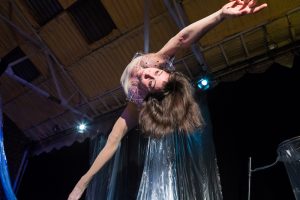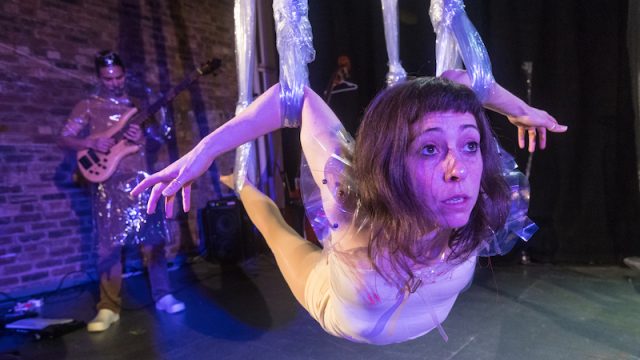This response was produced as part of the #CircusVoices scheme for developing critical practice around circus arts.
Review from: Summerhall, Edinburgh Festival Fringe; 9th August 2018

The Demonstration Room at Summerhall is washed in red light. The sound of a muffled heartbeat pulses. A growing soundscape develops as musician and composer Balazs Hermann creates, loops and layers sounds of the would-be womb. Suspended in a water-filled sac, awaiting the birth of her show, is performer – and co-founder of aerial group Paper Doll Militia – Sarah Bebe Holmes.
The sac comes alive and in a gush of water and limbs Holmes drops into our world naked, wet, and alive. Egg is her story and she has spent the last ten years developing it, basing the narrative on her own personal journey of helping a friend conceive through egg donation. Holmes portrays her younger self, as well as Carol, the friend, and a nameless doctor. She literally steps into the shoes of each character portrayed, changing from the smart heels of a middle-aged guidance counsellor, to the tough boots of younger Sarah, to the sensible shoes of a doctor.

The rest of the costuming is minimal, as is the set as a whole. Everything is plastic and transparent – the tubing and cellophane sheeting used as unconventional aerial apparatus, the coats worn by the doctors (a second doctor is portrayed by Hermann, who also takes on the role of Carol’s husband), and the small cubes used throughout. While watching, one has to wonder about the significance of the plastic’s transparent nature. Could it symbolize the sterility of medicine, the “artificial nature” of conceiving through in vitro fertilisation, or the transparency and vulnerability demonstrated by Holmes through the telling of her story?
The story weaves in and out of the different characters’ feelings, both physically and emotionally. There is love, joy, acceptance, uncertainty, anger, sadness, and angst. There is also a good deal of factual medical information from Sarah’s particular journey throughout the show, and it’s daunting to hear let alone go through, as Holmes did and portrays. As part of the overall narrative, the technical terminology and legal ramifications of donating eggs to another couple works well. It adds weight to the discussion, and clarifies to both young Sarah and the audience that this is a decision that must be made with not only the heart, but also the head.

There are four aerial acts in Egg, each portraying a different time for Holmes throughout the process. The first, performed on a series of bundled plastic tubing and before any medical procedures, is up-tempo, bouncy, showing off Holmes’ skills through dynamic releases and quick drops. It is quite flippant and representative of youthfulness. Later, as the hormone therapy takes its toll and her eggs are ready to be harvested, the aerial work become more aggressive and dark. Wrapped at the wrists and ankles, suspended from four lengths of plastic tubing in a sling-like apparatus, Holmes twists and writhes through her routine, her limbs broken and jagged. In the other two pieces of aerial work, cellophane-looking sheeting takes the place of aerial fabric. The plastics make a screaking sound as she wraps, uncomfortably sticking to her sweaty body. There are no graceful movements, and few long lines or pointed toes that are often seen in more conventional aerial pieces. She is showing us the physical embodiment of the trauma caused by the necessary and aggressive hormone therapy.

Hermann’s music and multimedia animations, created by Touzie Tyke, add sonic and visual layers to Egg and Holmes’ performance. Compositions performed on double bass and other non-traditional instruments almost create another character in the show, giving voice to Holmes’ uterus, Fallopian tubes, and eggs. To further this thought, animations of how her body changes, shifts, and mutates throughout hormone therapy also personify her reproductive system. At one point, a huge projection of her organs looks almost devil-like. All of these visuals and sounds are further amplified by the excellent lighting designed by Brian Hutchinson.
If you are going into Egg with expectations of grandiose aerial acrobatics and glittery costuming you may be disappointed and, at times, the narrative does lag. Additionally, if you or a close loved one has experienced infertility or IVF treatment, there are certainly triggers throughout Egg to be aware of when attending. Procedures are not the same in every country either, which is not explicit. Don’t let this stop you from seeing this show if you have the chance though, because the beauty of Egg is not necessarily in the circus performance – although they are beautiful. The beauty in Egg lies in the honesty of its story and the emotion that it evokes in the audience.




